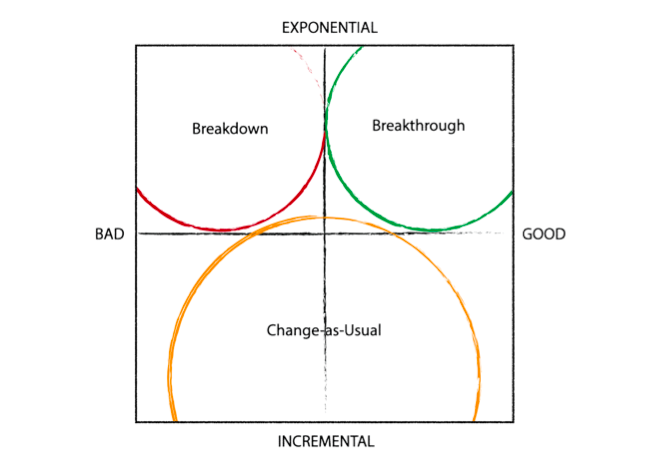Moving our needle: the breakthrough compass
With less than one week left to register for Critical Mass serial entrepreneur John Elkington explains why breakthrough innovation, rather than ‘change-as-usual’ development, is vital to achieving critical mass in solving pressing social challenges.
As change agents, we are encouraged to move the needle, raise our game, push the envelope – and, yes, help build critical mass towards system change. Our consciences nag us to stretch our horizons, ambitions, goals and targets. True, ambition can be our rocket fuel, carrying us to new and unimagined heights – but it helps to have at least some sense of our aiming point before someone lights the blue touch paper.
Aiming points are easier to identify if the world is relatively stable, although Mongol horsemen – those harbingers of instability – were past masters at hitting moving targets, proving we can do it if minded to do so. But the challenge is now more complex, involving hitting multiple targets, moving at different speeds and, often, in different directions. Just think of the UN’s 17 Sustainable Development Goals and the linked 169 targets.
We see two tensions now stretching the linked social innovation and sustainability agendas. The first involves a shift from a consideration of the negative impacts of a technology, product, company or economy to its positive impacts. The second involves a growing sense that incremental solutions are not up to the challenge of tackling systemic problems—coupled with a growing interest in ‘exponential’ thinking and business models. We might be uncomfortable with Uber, for example, but it heralds a world where we might need radically fewer cars.
Combining these trends, we developed the Breakthrough Compass. This has two axes, one (horizontal) showing the nature of impact (from ‘bad’ to ‘good’), the second the degree of scaling achieved (from ‘incremental’ to ‘exponential’).
Breakthrough Compass

Source: Volans, 2015
True pioneers need to know which they operate. Here are three different scenarios in which chain reactions will need to be triggered:
- Breakdown: a future where early experiments and enthusiasm fade in the face of incomprehension and failure of political nerve. Here we override a growing range of planetary boundaries including the health or our ecosystem and climate stability – and any solutions tend to favour the 1% over the 99%.
- Change-as-Usual: the world where most of us operate, most of the time. Many approaches now in widespread use were once semi-revolutionary, including socially responsible investment and sustainability reporting. But the level of ambition is often much lower than it needs to be. We work hard to patch an increasingly dysfunctional system.
- Breakthrough: With the usual ups and downs, our societies and economies push toward a very different set of outcomes. Here, innovators, entrepreneurs, intrapreneurs, investors and – crucially – policy-makers manage to work together to build a new system, fit for purpose in a world of seven going on ten billion plus people. This is already happening in places, but a key part of our challenge involves connecting the breakthrough dots.
In the Breakdown scenario, critical mass is often developed in emergencies, as it should have been sooner with the recent European refugee crisis. And this is only the beginning, with climate change likely to spur future migration waves. We must work to prevent such crises—and mobilize fast when they begin.
In the Change-as-Usual scenario, critical mass is built around things like supply chain challenges, sustainability reporting and socially responsible investment. All important, all necessary, but way short of sufficient. By contrast, Breakthrough innovation pushed into the top tight-hand quadrant of the Compass, potentially scale near-exponentially, shrinking our negative impacts and expanding positive outcomes.
The Compass is an attempt to capture and simplify the dynamics of the forward agenda both for business and for society. Currently, it is easier to map initiatives into the Breakdown and Change-as-Usual spaces, but there will be huge market opportunities for Breakthrough innovation and capitalism in the coming decade. New forms of critical mass will be needed: social, political, economic and technological. But our hunch is that by 2025 it will be hard to find the space in the diagram to squeeze in the burgeoning number of successful ventures.
John Elkington is co-founder and Executive Chairman of Volans. His latest book, The Breakthrough Challenge: 10 Ways to Connect Today’s Profits With Tomorrow’s Bottom Line, is co-authored with Jochen Zeitz and published by Jossey-Bass.
To find out more about Critical Mass – the UK's leading conference on social enterprise, social investment and responsible business – please click here.
Photo credit: Calsidyrose



